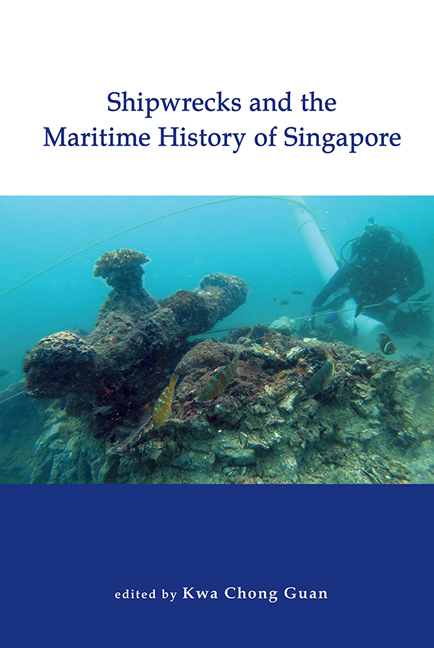Book contents
- Frontmatter
- Contents
- Foreword
- Acknowledgements
- Contributors
- 1 Introduction: Two Historical Shipwrecks and Their Implications for Singapore History
- 2 The Temasek Wreck
- 3 The International History of Temasek: Possibilities for Research Emerging from the Discovery of the Temasek Wreck
- 4 Singapore’s Waterways before the Modern Era
- 5 A Seventeenth-Century Port Settlement in the Kallang Estuary
- 6 The Shah Muncher
- 7 Singapore and the Country Trade in the Late Eighteenth and Early Nineteenth Centuries
- Index
7 - Singapore and the Country Trade in the Late Eighteenth and Early Nineteenth Centuries
Published online by Cambridge University Press: 01 March 2024
- Frontmatter
- Contents
- Foreword
- Acknowledgements
- Contributors
- 1 Introduction: Two Historical Shipwrecks and Their Implications for Singapore History
- 2 The Temasek Wreck
- 3 The International History of Temasek: Possibilities for Research Emerging from the Discovery of the Temasek Wreck
- 4 Singapore’s Waterways before the Modern Era
- 5 A Seventeenth-Century Port Settlement in the Kallang Estuary
- 6 The Shah Muncher
- 7 Singapore and the Country Trade in the Late Eighteenth and Early Nineteenth Centuries
- Index
Summary
The Shah Muncher was a British country trader that was on its return voyage in 1796 from China to Bombay when it sank off the rocky outcropping of Pedra Branca. The British port of Singapore had of course not then been founded, but it is well within the realm of possibility that the ship travelling westward intended to call at one of the nearby ports of the Singapore and Melaka Straits. This might have been Riau (approximately today's Tanjung Pinang) on the island of Bintan, or perhaps even Melaka, where the ship could have taken on fresh water and provisions before sailing on to India.
This chapter does not discuss the ship or its cargo as such, but rather outlines in broad strokes the economic and political context in which the Shah Muncher was operating. To this end, the temporal scope of this chapter straddles the eighteenth and the early nineteenth centuries. It is perhaps opportune to define at this juncture the nature of the seaborne trade we are concerned with. What is country trade? And what is a country trader? Simply put, country trade refers to private trade within (or sometimes outside of) an established trading monopoly. European country trade in the Indian Ocean reaches back to the time of the earliest Portuguese explorers and adventurers at the turn of the 1400s and 1500s. But the most familiar monopoly would be the one held by the British East India Company based in London towards the modern period. Even though country trade could and did assume different forms, the term generally refers to private trade in certain commodities between specific ports. Linked to the country trade, the expression “country trader” then refers either to a natural person who carried out the trade, usually the captain or owner of the vessel who sailed under a particular national flag—in the specific case of the Shah Muncher it would refer to the British flag—or could otherwise refer to the entire ship. It should be stressed that private or country traders hailing from different parts of Europe became active in seaborne trade, especially in the Western Pacific and Indian Ocean during the second half of the eighteenth and early nineteenth centuries.
- Type
- Chapter
- Information
- Shipwrecks and the Maritime History of Singapore , pp. 101 - 108Publisher: ISEAS–Yusof Ishak InstitutePrint publication year: 2023



